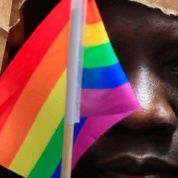Refugees are some of the most vulnerable people in the world, but we often forget just how diverse refugee populations are, and not just in terms of ethnic or religious background but also sexuality and gender identity. LGBT refugees can face even greater vulnerabilities in many areas including attempts to seek asylum and persecution in their own countries. They can also face greater risks when placed in immigration detention.

It is no exaggeration to say that LGBT persons in many parts of the world face persecution, discrimination and violence because they may not fit — or be perceived to fit — into a society’s dominant conception of sexuality and gender identity. Many advocates have referred to these compounding vulnerabilities and risks as a “double marginalization/victimization.”
Indeed, LGBT persons often face direct discrimination from governments, the local and wider community, family and the workplace. Often, LGBT persons are threatened by direct violence related to their gender as well as the wider issues of violent conflict and war, natural disasters and the economic instability that forcibly displaces peoples in the first place.
In Depth:
Migrant and Refugee Rights
In particular, the UNHCR says there are increasing numbers of LGBT persons fleeing the Northern Triangle of El Salvador, Guatemala and Honduras, statistically one of the most violent regions in the world, let alone for LGBT folk.
At least 594 LGBT persons were killed in the Americas between Jan. 2013 and March 2014. A further 176 were seriously assaulted, according to research by the Inter-American Commission on Human Rights (IACHR).
While the numbers for LGBT refugees are difficult to predict, there are currently 77 countries where consensual same-sex relations are criminalized, according to United Nations Free & Equal, an organization set-up to raise awareness and promote gender equality. As a result of this, the number of LGBT persons claiming asylum has steadily risen, according to the Rights in Exile Program.
The UNHCR estimates that 37 countries have so far granted asylum to refugees on the basis of their sexuality or gender identity. But despite increasing evidence of violence and persecution of LGBT persons, no fixed standard currently exists which recognizes LGBT folk as a refugee sub-group when fleeing to other countries.
Under the 1951 Geneva Refugee Convention, people are able to claim asylum on the basis of a “well-founded fear of persecution based on race, religion, nationality, political opinion, or membership of a particular social group.”
But many LGBT persons may not wish to reveal their sexuality or gender, fearing further persecution. On the flipside, it can sometimes be difficult for individuals to prove they are LGBT, particularly if their country does not legally recognise same sex relationships or their legal identification does not match the person’s preferred gender.
LGBT persons may also be doubly discriminated against in their host country, not just as a foreigner but also in terms of their preferred gender identity. For example, landlords might discriminate against them in the search for adequate housing, or potential employers may discriminate against them as they seek to build a livelihood through employment.
A 2014 report by Heartland Alliance found that many Syrian LGBT refugees who fled to Lebanon experienced discrimination in their new country. It found that only 7 percent of those that were interviewed reported physical abuse to authorities. Homosexual acts in both countries can be punishable by jail.
LGBT refugees are also extremely vulnerable to being detained in immigration detention. Earlier in June, a groundbreaking report by the International Detention Coalition released a paper titled: “LGBTI Persons in Immigration Detention," which revealed that transgender persons in a California correctional facility were 15 times more likely to be sexually assaulted than the general detention population.
Physical and sexual violence against LGBT persons is perpetrated by inmates as well as detention staff, who often turn a blind eye to various forms of violence against the community. In fact, around half of all sexual abuse in U.S. prisons is believed to be committed by staff members.
LGBT persons can also be detained with others likely to persecute them, including nationals from the same country they originally fled from. Sometimes, LGBT persons are segregated from other detainees against their will for “protective custody,” making them a more visible target for abuse.
Detention facilities rarely match the preferred gender, but are instead assigned by authorities based on heteronormative perceptions of gender, again increasing the risk of abuse. In 2011 a transgender woman was detained in a male prison in El Salvador and was raped over 100 times, according to the U.N. Special Rapporteur on Violence against Women.
Screening processes often fail to adequately identify LGBT people at risk. Forced nudity and body searches increase the risk of humiliation and discrimination while proper medical care provisions are often inadequate. There is also limited ability for persons going through gender transitions to continue treatments such as hormone replacement therapy while in immigration detention.
To add to all this, LGBT persons in detention are often referred to as “shemale” or even “it,” which can result in long lasting psychological damage, according to a number of advocacy organizations and the U.N. Special Rapporteur on Torture.
As higher levels of awareness about LGBT persons within society develop and advocacy groups continue to pressure governments in the fight for equal rights, it is hoped that LGBT refugees will be better accommodated for and protected. Recent efforts from the UNCHR to recognize LGBT persons as a particular social group under the 1951 refugee convention are a step in the right direction. But as the world witnesses record numbers of peoples being displaced, much more needs to be done to raise awareness and protect these vulnerable communities from the multiple — often deadly — oppressions they face.